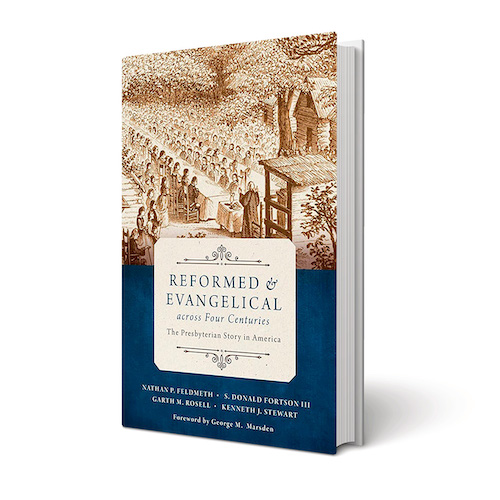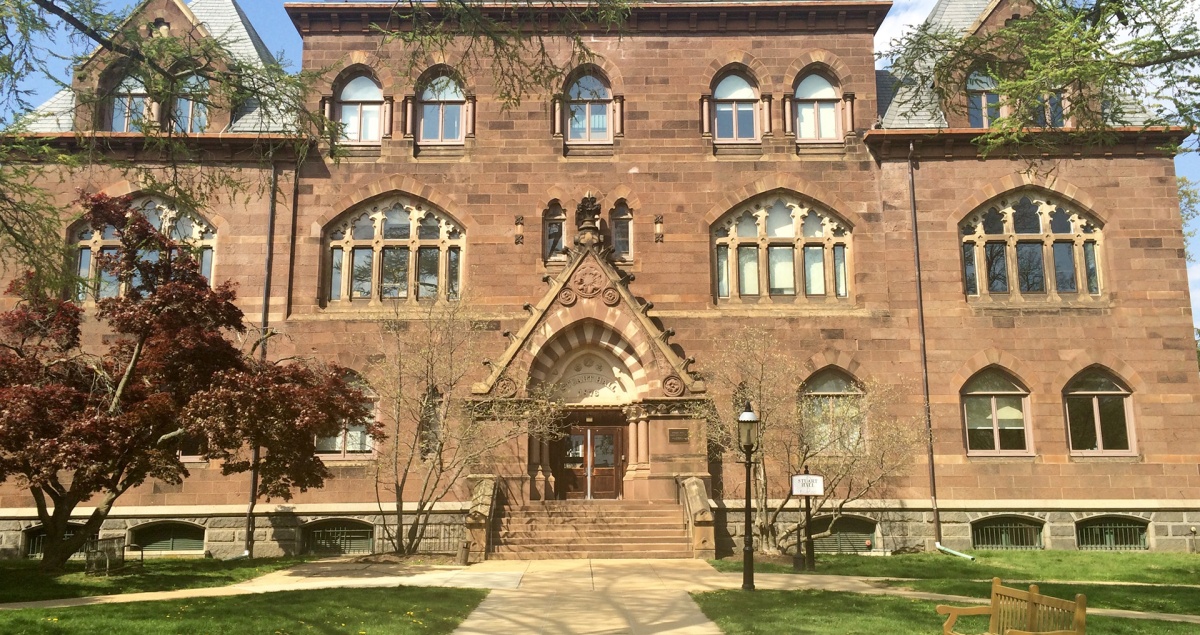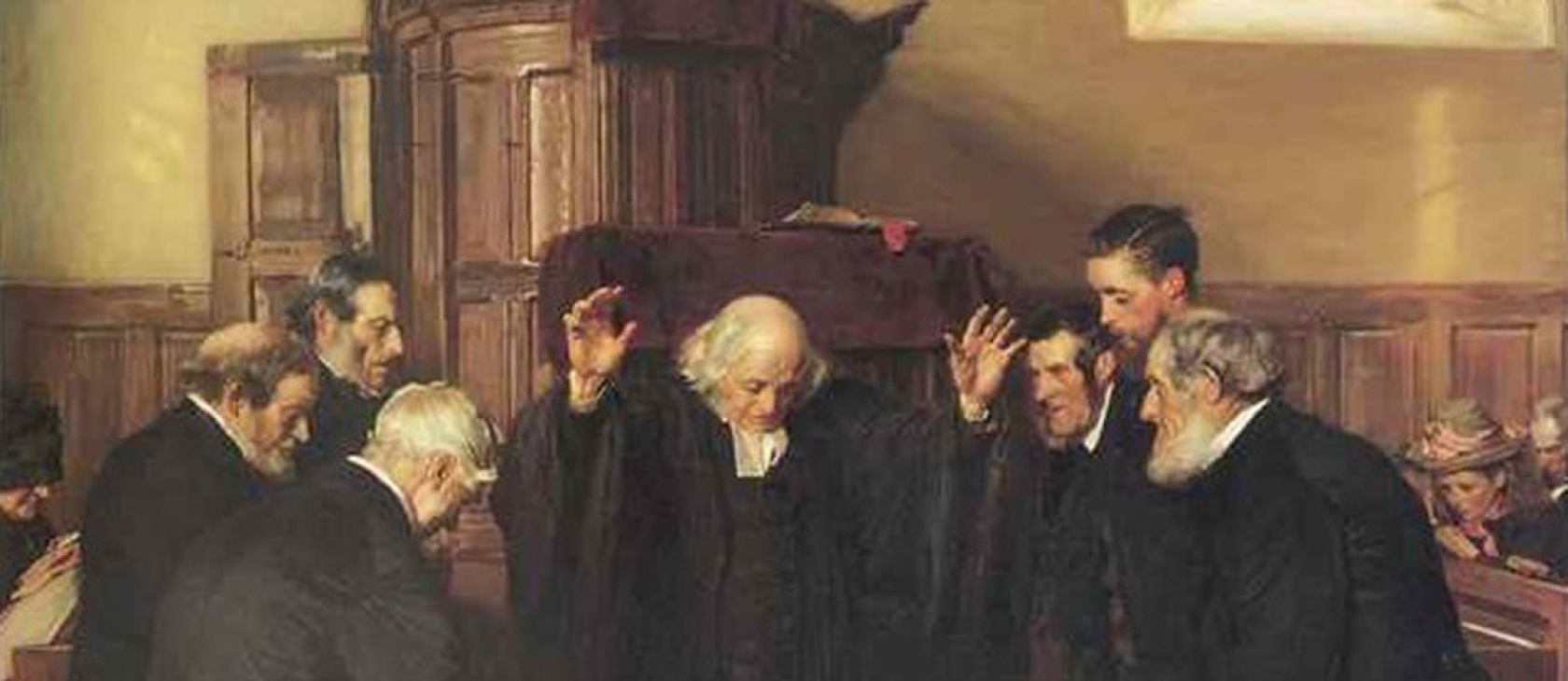Presbyterians continue to play an important role in American religious life. While making up less than 5% of the population today, historically Presbyterians have punched above their weight in both politics and governance. Eleven signers of the Declaration of Independence were Presbyterians; nine members of a Presbyterian church have served as president of the United States. During the earliest days of the republic, it was Presbyterians who were among the leading lights in industry and political theory—so much so that in 1776, King George III was advised that the Revolutionary War was “a Presbyterian war from the beginning.” Though the exact quote is disputed, King George is said to have referred to it in a similar way, as “a Presbyterian rebellion.”
A new one-volume history of the Presbyterian tradition in America seeks to situate it firmly in the broader evangelical movement. But if all evangelicals are not Presbyterians, is it fair to say that not all Presbyterians are evangelicals?

By Nathan P. Feldmeth, S. Donald Fortson III, Garth M. Rosell, and Kenneth J. Stewart
Foreword by George M. Marsden
(Eerdmans, 2022)
It is surprising, then, that there is not an up-to-date, standard single-volume account of the history of Presbyterianism in America. This is the role that Reformed & Evangelical Across Four Centuries: The Presbyterian Story in America (R & E) aims to fill. It is a significant book with aspirations that will serve students and historians well.
When it comes to single-volume histories, the 2007 volume by D. G. Hart and John R. Muether, Seeking a Better Country, comes the closest and in many ways holds together the most cohesively. There are also older books, including those by Leonard J. Trinterud and the slightly later volume, A Brief History of the Presbyterians, by Lefferts A. Loetscher, both of which the authors of R & E cite. There are also several histories that focus on a specific stream of Presbyterianism in the United States, whether regional or denominational. R & E represents an attempt to present the Presbyterian story more broadly. While this book aims at becoming the single-volume standard, it is a multiauthor effort: while all are Presbyterians, the contributors are in different Presbyterian denominations and thus represent different streams within the American tradition. Their individual contributions are not delineated, but there are sections of the book that read differently from others.
The first obvious strength of R & E is the attention it devotes to the origins of Presbyterianism in England and Scotland. This section (roughly the first 80 pages) is the strongest and most detailed. While it devotes less attention to the role of Calvin and other European Reformers in the development of Presbyterianism, it more than makes up for this by providing a carefully researched and clearly presented account of the specifically English and Scottish theological soil into which Genevan convictions were planted and eventually took root.
The writers avoid the usual focus on Calvin and Geneva because of a desire not to obscure other sources of influence. They state at the outset that “a too-rapid emphasis on Genevan influence becomes an obstacle to fuller understanding.” No doubt this can be the case, and they instead go into fuller detail regarding the influence of Luther on the English church and on Elizabethan era Puritan preachers. Without question, Luther had an outsize influence on the development of Protestant theological sensibilities in England, but an argument could be made that the formative influence of John Calvin on the Scottish church in general and on John Knox in particular deserves special pride of place in tracing the origins of a movement that would be codified in documents heavily influenced by Scottish theologians and by a practice of church government that had its earliest English-speaking expression in Scotland.

The big question hovering over the entirety of the book is that of definition. While R & E aims at being a sweeping history, it is particularly concerned with giving an account of those strands of Presbyterianism that fit within the later consensus movement of evangelicalism. This leads to some internal tensions that are not always synthesized by the authors themselves. An especially noteworthy example of this is the section of R & E that engages with the work of David W. Bebbington. Bebbington has argued persuasively that the evangelical consensus revolves around four emphases, known by those who follow him as the “Bebbington Quadrilateral”: biblicism, conversionism, crucicentrism, and activism. Bebbington notes the emergence of this evangelical consensus in the 1730s, connecting it directly to the work of John Wesley and others in the so-called Great Awakening.
R & E, by contrast, tries to demonstrate that these four emphases were found in earlier Presbyterianism. It makes a convincing case that the key elements of the later evangelical movement were not merely a result of the Great Awakening; rather, the later evangelical coalescence around the quadrilateral was built on existing Presbyterian emphases. While this continuity between post-revival Presbyterians and their forefathers in England and Scotland is important, it may be slightly beside the point. Bebbington’s thesis is not that these elements individually—or even all of them together—were entirely new. Rather, their significance lies in the fact that they move from being features found within the context of a larger theological and ecclesiological system (such as Presbyterianism) to becoming the glue that holds together the evangelical movement. In other words, they become foundational, defining elements of a multidenominational movement that exists apart from traditional concerns about ecclesiology or the sacraments. The elements of the quadrilateral were not introduced in the 1730s, but earlier Protestants (many of whom evidenced these convictions, as R & E demonstrates) saw the narrower convictions regarding ecclesiology, worship, the Lord’s Supper, and baptism as far more significant. They were less willing to set these aside for the sake of a broader coalition. But this concern to emphasize the evangelical bona fides of Presbyterianism is central to R & E; it is throughout the book and expanded upon in its conclusion. There the authors express a hope for the further strengthening of Presbyterianism through revival and for its renewed commitment to the transformation of culture through the efforts of multidenominational organizations such as the National Association of Evangelicals.
This central question of definition also plays a prominent role in the debates around subscription to the Westminster Standards. As this volume demonstrates, the question of confessional subscription emerges much earlier than is often recognized. The authors trace the beginning of the debate to the Great Ejection in 1662, when thousands of Puritan ministers were forced out of the Church of England upon the Act of Uniformity and the Restoration of the monarchy. From that point forward, Presbyterians were decidedly outside the theological mainstream in England, so the question of what bound them together was an open one. Although the authors are careful to treat this question dispassionately, it must be noted that, throughout the history of Presbyterianism, those who have argued against the need for robust confessional subscription are shown to have slid into something that hardly resembles traditional Presbyterian teaching at all—often in a short period of time.
About halfway through R & E, the book moves from being an essentially straightforward chronological narrative to more of a topical treatment arranged chronologically. It is in this part of the book that questions of Darwinism, civil rights, women in leadership, and modernism are addressed. Also addressed is the role of seminaries in meeting the growing need for ministers in the 1800s. Special consideration is given to Princeton Theological Seminary, which is dealt with both in a more general way and then again in a chapter on the influence of German universities. This is appropriate, but it could still be argued that the distinctive approach to ministerial training and to confessional subscription displayed in other seminaries played an even more significant role in the history of American Presbyterianism, especially during westward expansion, than this book would indicate.
Those who have argued against the need for robust confessional subscription are shown to have slid into something that hardly resembles traditional Presbyterian teaching at all.
These topical chapters, while necessary given the concerns of our day, nonetheless read differently from the earlier ones. This may be related to the timing and nature of their composition—perhaps they were composed as standalone articles—but it also has to do with their subject matter. It is much easier to provide a neutral and unifying account of Presbyterian history when addressing historical matters on which there was widespread consensus among Presbyterians; but the more modern issues that R & E seeks to discuss have been handled in decidedly different ways by different branches of the Presbyterian church. Many of these issues also arose in a context in which fragmentation among Presbyterians had already taken place. In other words, not only was there an absence of uniformity among Presbyterians about how to address something like modernism or the civil rights movement; there were also by that time many more Presbyterian bodies struggling to understand and address these contentious developments. It is not entirely clear that the evangelical distinctives highlighted throughout the book provide a useful guide in navigating these controversies. The authors recognize this diversity of views and attempt to treat them by offering summaries of various Presbyterian denominational responses. But it is impossible to avoid oversimplifying the varied approaches or to keep from ignoring the approaches taken by smaller Presbyterian communions, even if one might argue that the responses of these smaller denominations better reflect what it means to be both evangelical and reformed.

The laudable attempt of R & E to handle these questions is one of the great strengths of the book. But it does highlight a tension inherent in the authors’ task. They clearly aim to position the healthiest Presbyterians as reformed and evangelical—both in their earliest expressions and in their current practice. But if the healthiest and truest expressions of Presbyterianism are the reformed and evangelical ones, then why does the response of the PCUSA to missions or to homosexuality merit so much greater attention than that of the OPC or the PCA, as it does in this volume? To be sure, the PCUSA (and its earlier designations) was and is the largest American denomination calling itself Presbyterian, but during the periods in which those issues became especially controversial, it could be argued that the mainline church was neither reformed nor evangelical (in a Bebbington sense), so why devote so much attention to their response? At what point do the criteria of evangelical and reformed render the largest Presbyterian denomination in America tangential to the story?
None of this is meant to detract from the significant achievement of this book. It is an important and useful volume. The first part of Reformed & Evangelical Across Four Centuries is outstanding, and the second, more topical section provides a helpful starting point for inquiry into issues that have not only divided Presbyterians in America but have divided Americans as a whole. The tensions inherent in R & E point not to a deficiency in the book but rather to the difficulty of defining the parameters of a broad sweeping account. The authors of R & E seek to demonstrate that Presbyterianism is an expression of the Christian faith that is both reformed (with varying views on subscription) and evangelical (with historical differences on revivals and cooperation). In so doing, they provide an enlightening history of a movement that has had an enormous historical influence, offers a vibrant ongoing witness, and lives with a host of internal divisions.








